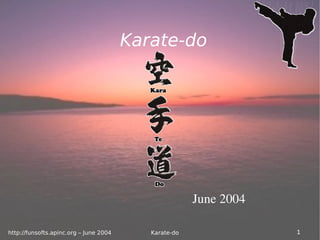Karate-do
- 2. Contents Introduction History Master Gichin Funakoshi Three aspects Hierarchy of belts KiAi Equipment Natural weapon : the hand Natural weapon : the leg The End
- 3. Introduction Japanese martial art Involves a variety of techniques, including blocks, strikes, evasions, throws, and joint manipulations Kara means empty; te means hand; do means the way, thus karate-do means "the way of the empty hand" ~40 million practitioners world-wide (1996, Okinawan Prefectual Board)
- 4. History
- 5. Master Gichin Funakoshi Founder of modern karate-do Born in Okinawa Bought his forms and style to mainland Japan "The ultimate aim of karate lies not in victory nor defeat, but in the perfection of the character of its participants" (1868-1957) Okinawa
- 6. Three aspects Kihon basic training drills pair work or solo exercises Kata means forms, is a fight against imaginary enemies, it is a fixed sequence of moves. used in competitions (individual or team) Kumite means sparring, develops from well defined forms to the free form named randori (means "chaos taking") used in competitions (individual or team)
- 7. Hierarchy of belts Change with the style For the Shotokan style : 10th Kyu - White 9th Kyu - Yellow 8th Kyu - Orange 7th Kyu - Green 6th Kyu - Blue 5th Kyu - Second Blue 4th Kyu - Brown 3rd Kyu - Second Brown 2nd Kyu - Third Brown 1st Dan+ - Black
- 8. KiAi Made up of the ideogram "Ki" (means energy or spirit) and the ideogram "Ai" (means matching or union) KiAi means "working with Ki" or "harmonizing Ki" or "uniting the spirit." Powerful vibrations that paralyze the adversary for a brief instant. Start from the hara (the lower abdomen or intestines - the ocean of energy), not the throat - observe like a cat meows or a lion roars ŌĆ£One cry, one instant containing all space-time, the whole cosmos.ŌĆØ (Taisen Deshimaru)
- 9. Equipment Karate Gi / Kimono with belt For the kumite : Sparring gloves - Groin protector - Mouth guard
- 10. Natural weapon : the arm
- 11. Natural weapon : the leg
- 12. The End Any questions ? Thank You !











